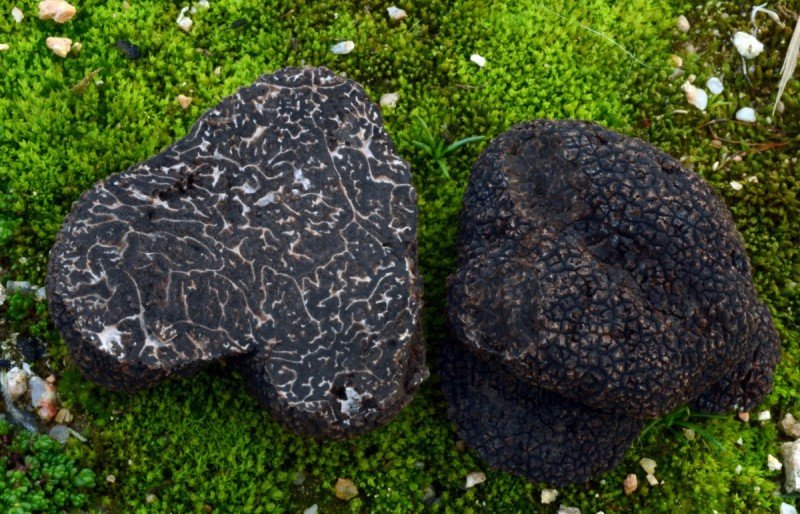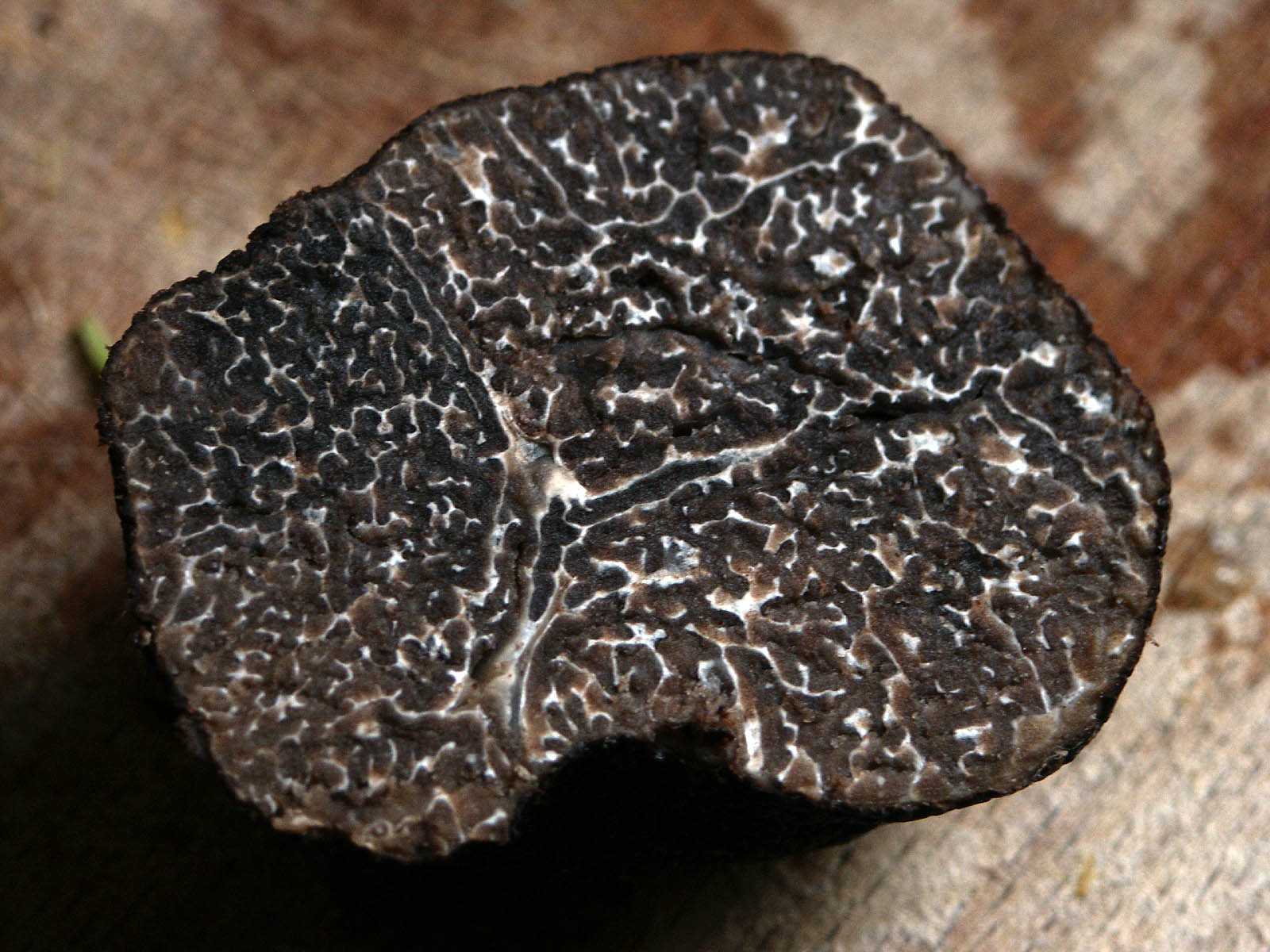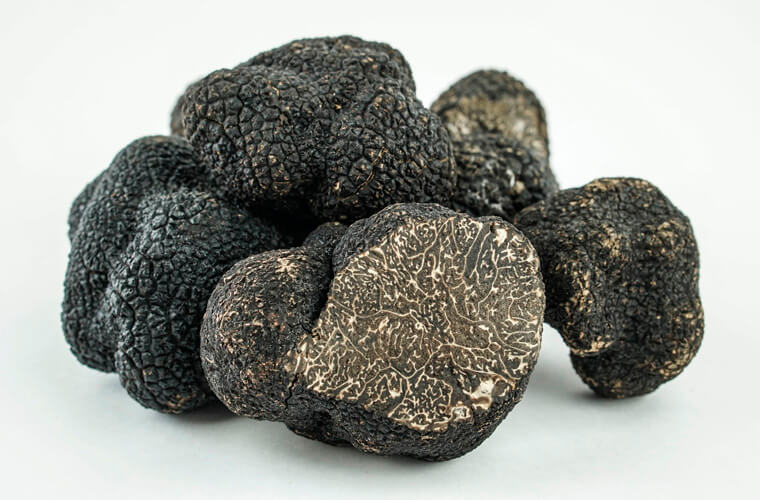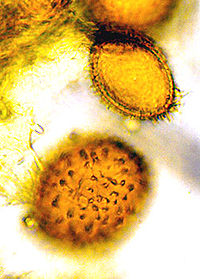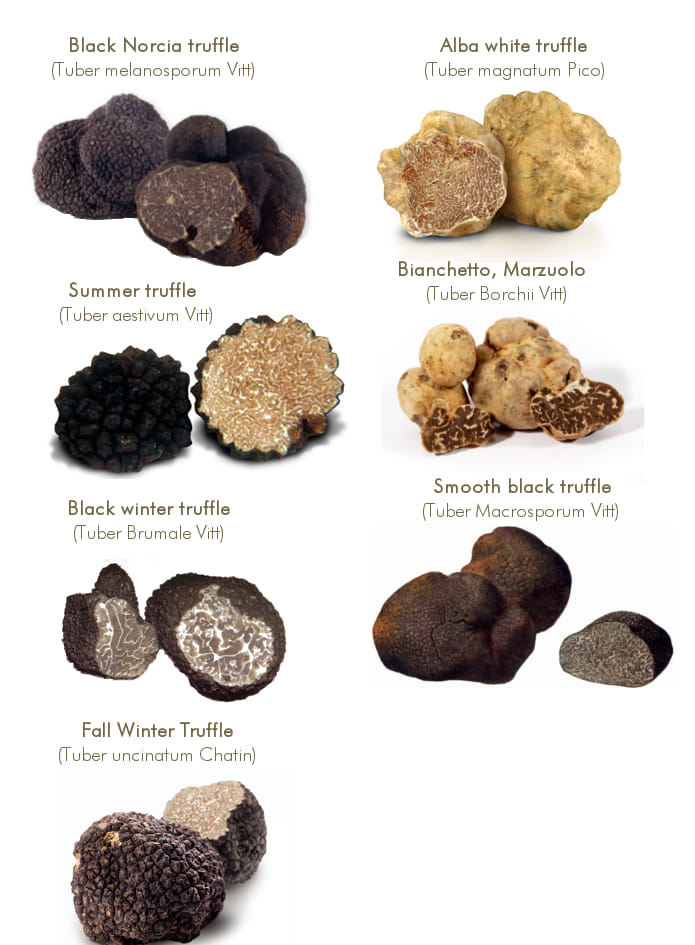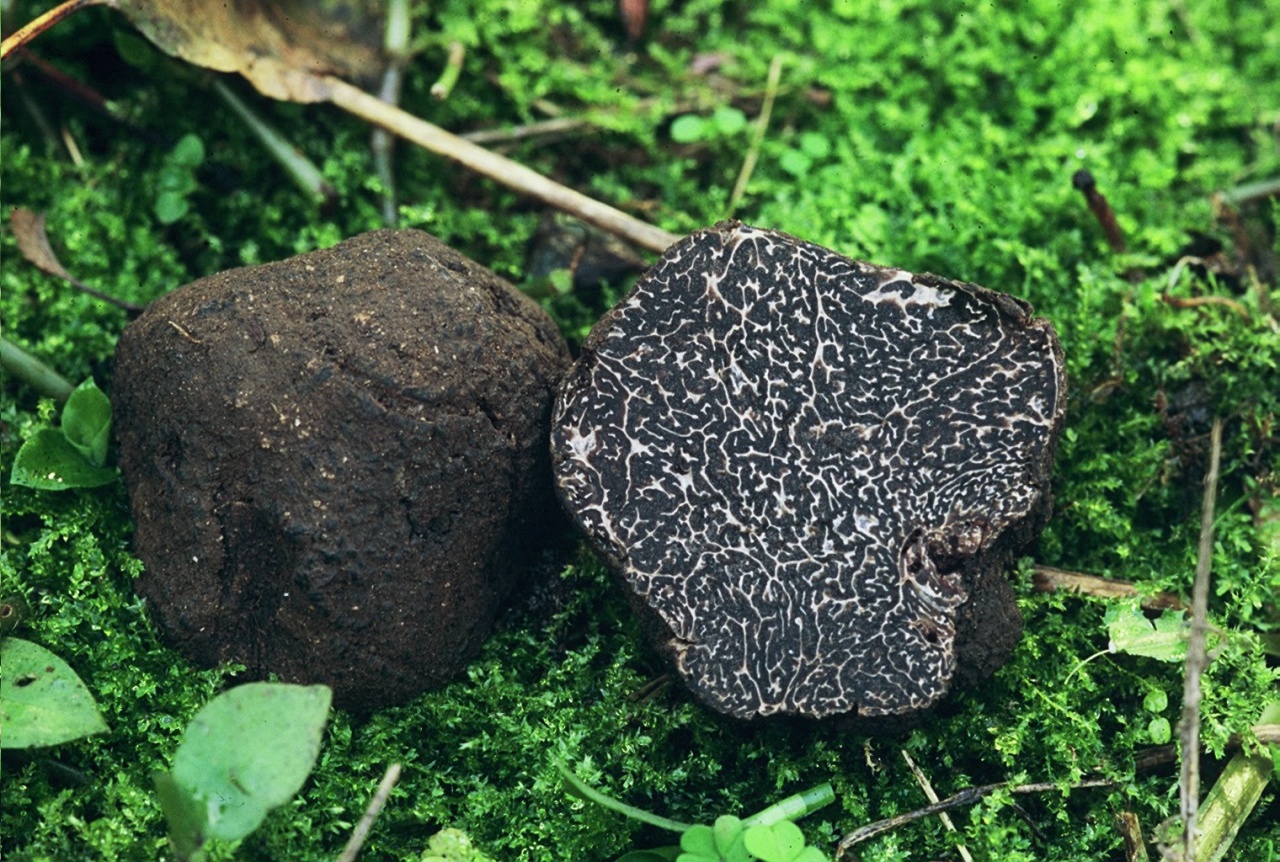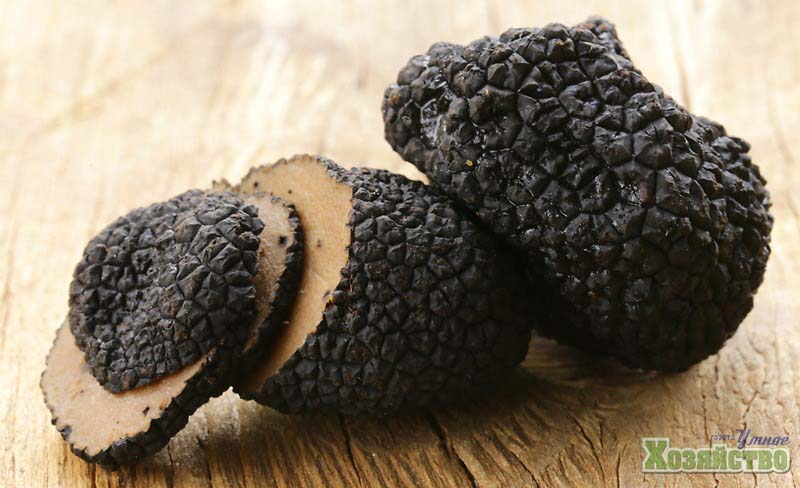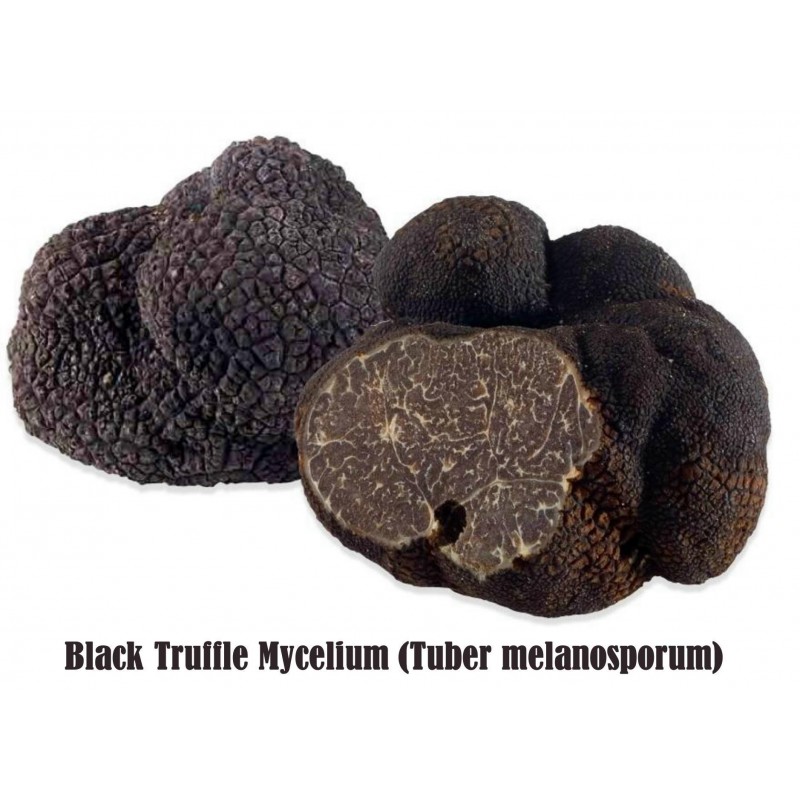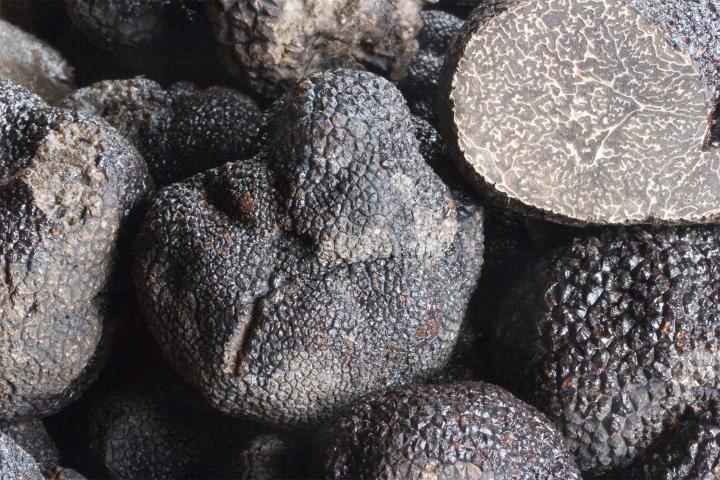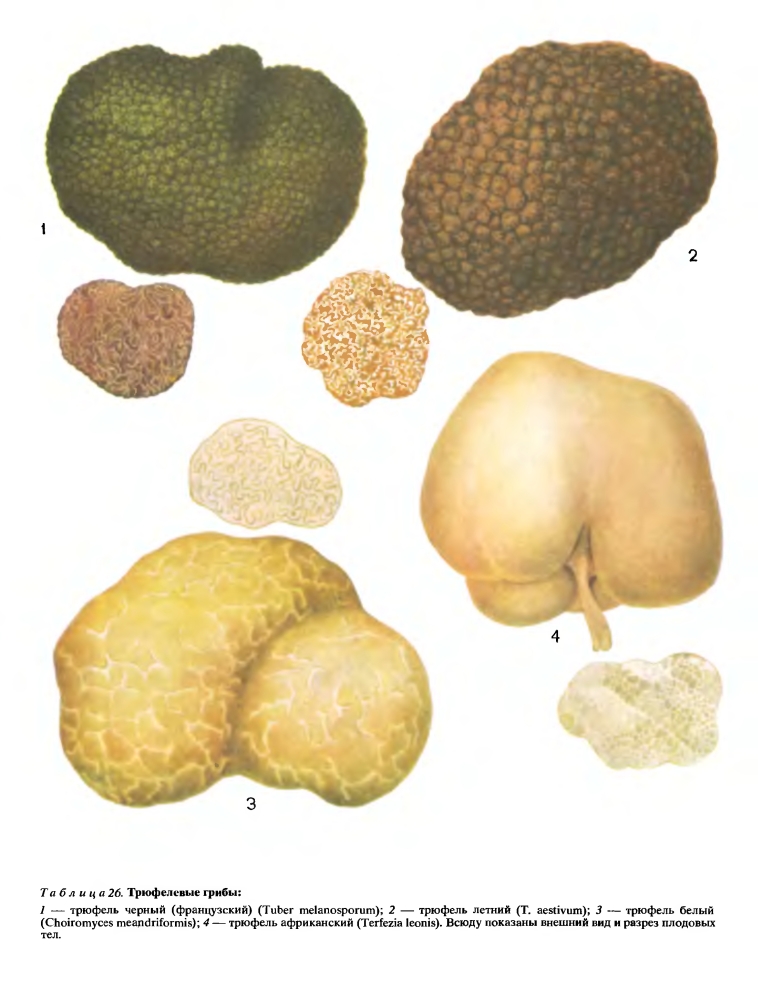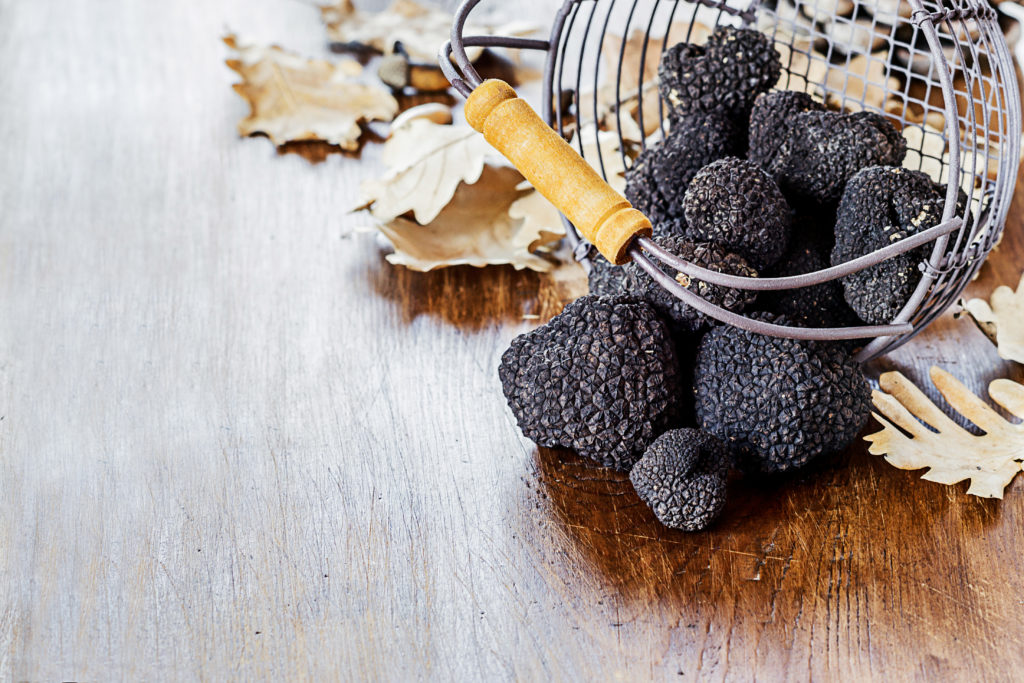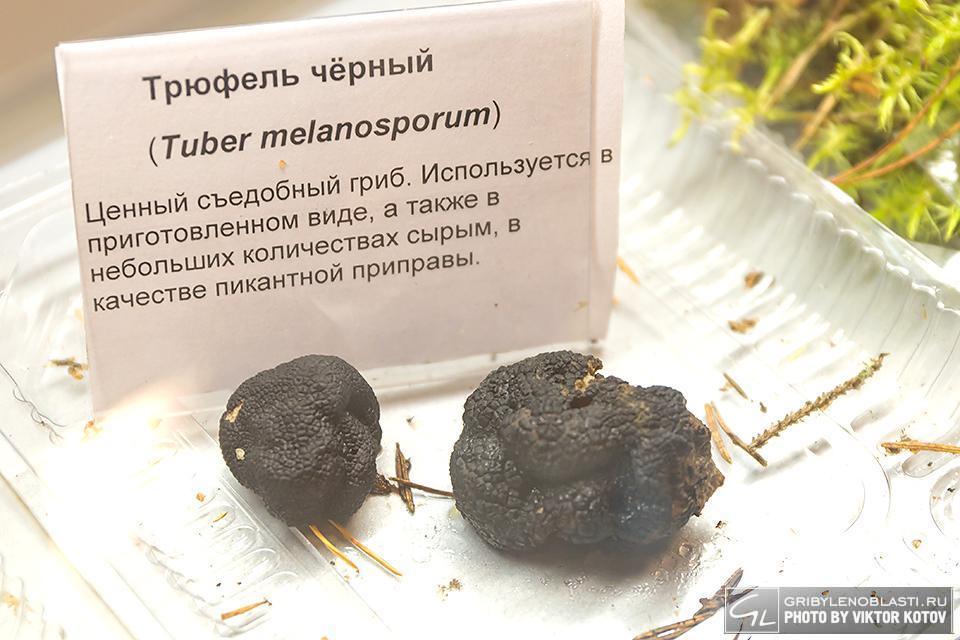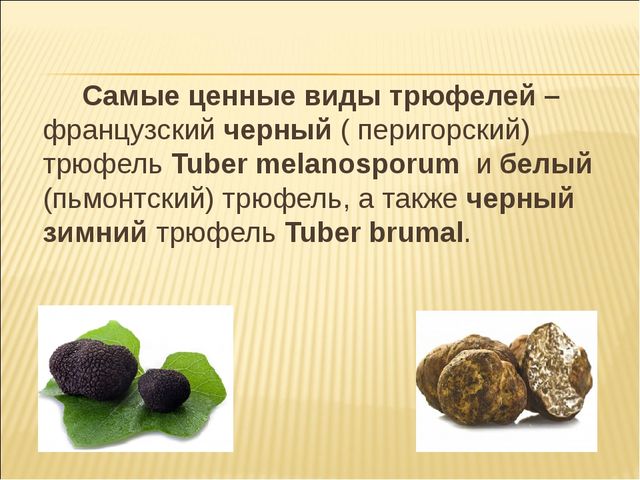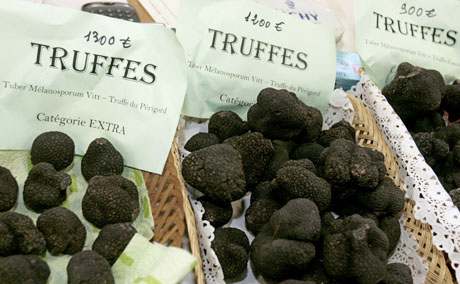Practical value
Real truffles are edible. They have a mushroom flavor with deep roasted seeds or walnuts and a strong characteristic aroma. If a truffle is immersed in water and held, then it acquires the taste of soy sauce.
The most appreciated by gourmets are Perigord, Piedmont and winter truffles, which grow in oak and beech groves in Southern France, Switzerland and Northern Italy, where they are of great industrial importance. In Russia, one species is found - summer truffle (Tuber aestivum).
In France and Italy, dating back to the 15th century, the practice of searching for truffles growing in the forest with the help of specially trained search dogs and pigs, which have a phenomenally fine scent, is widespread: they are able to smell truffles underground at a distance of up to 2000 m. searching for truffles is also the so-called "Hunting for flies"; it is based on the fact that some flies from the family lay eggs in the soil in the vicinity of truffles (the larvae of these flies use the fruiting bodies of truffles for food), therefore, a truffle can be found under the foliage, having noticed midges swarming above it.
Contrary to popular belief, truffles can still be cultivated. There were already successful attempts in 1808. It was noticed that truffles only grew between the roots of some oak trees. In 1808, Joseph Talon (Joseph talon) planted acorns from those oak trees under which truffles were found. A few years later, when the trees grew, truffles were found under the roots of some of them. In 1847 Auguste Rousseau (Auguste Rousseau) planted 7 hectares of such acorns and subsequently collected a large harvest of truffles, for which he received a prize at the 1855 World Exhibition in Paris.
At the end of the 19th century, 750 square kilometers were planted with truffle groves, from which up to 1000 tons of "black diamonds of culinary" were collected. However, due to the decline of agriculture in France in the 20th century, many of the truffle groves were abandoned. The average fruiting period of truffle oaks is about 30 years, after which the yield drops sharply. As a result, although 80% of all truffles harvested in France come from special oak plantations, the annual harvest has dropped dramatically. Local farmers are opposed to new plantations, fearing a serious drop in prices for this delicious mushroom. The number of harvested truffles is decreasing from year to year. In recent years, the harvest of these mushrooms has not exceeded 50 tons. Currently, truffles are cultivated in the USA, Spain, Sweden, New Zealand, Australia and the UK.
French experts demand to ban the mixing of European truffles and Chinese ones, as this ultimately strongly affects the reputation of European products for which such mixtures are issued.
Other truffles
White, or Polish, or Trinity truffle (Choiromyces meandriformis) has a fruiting body with light pulp, similar in appearance and size to a potato. Edible. It grows in the forests of Western Europe, Ukraine, Belarus, as well as in the regions of central Russia (earlier it was mined in large quantities in the vicinity of Aleksandrov and Sergiev Posad).
Among the so-called steppe truffles, "tombolans" (genus Terfezia) are also edible. They grow in Southern Europe, North Africa, South-West Asia - in Azerbaijan on the Absheron Peninsula, in Nagorno-Karabakh, in the valley of the Araks River, in Central Asia and in Turkmenistan (Terfezia transcaucasica). In the same areas, the steppe truffle grows (Terfezia boudieri).
Sometimes truffles are mistakenly referred to as inedible basidiomycetes from the genus Scleroderma (a group of gasteromycetes), whose fruiting bodies look like round and oblong yellowish tubers 3-10 cm long; found in forests, parks; fruiting bodies are at first dense, blackish inside with light veins, unpleasant smelling; later their contents are sprayed.
Reindeer truffle, inedible for humans, is a species of the Elafomitses genus, which serves as food for rodents and deer.
Evaluation of taste, composition, medicinal properties, benefits and possible harm
Most sophisticated gourmets assure that they do not eat the truffle mushroom itself, but its smell.In expensive restaurants, truffle is served in thin transparent slices not as an independent dish, but is added to meat, vegetables and even desserts. The unique mushroom emphasizes and enriches the taste of such diverse dishes.
Mushroom composition:
- proteins -54.5%;
- carbohydrates - 36.6%;
- fats - 10%.
The main beneficial quality of the mushroom, according to nutritionists, is its low calorie content. Also, black truffle has a positive effect on all systems and organs:
- activates metabolic processes;
- lowers blood glucose and lipids;
- rejuvenates the epidermis;
- normalizes the state of the endocrine system;
- improves intestinal motility.
Useful properties: the mushroom is widely used to treat gout, increase potency in men and treat infertility in women. Eating truffles can harm:
- pregnant women;
- children under 12 years old;
- people suffering from peptic ulcer diseases;
- allergy sufferers.
Application in cosmetology
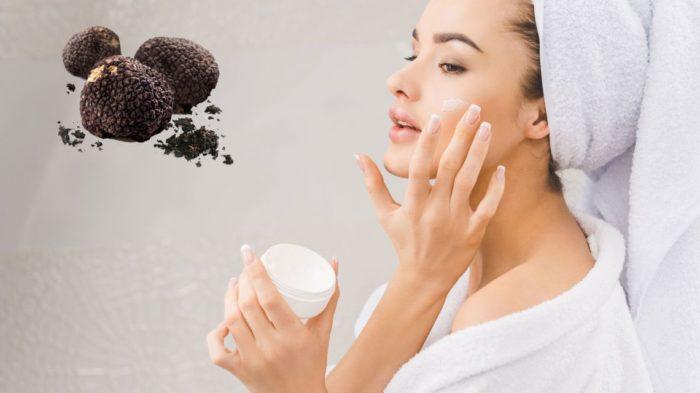 Black truffle is used to make perfumes, shampoos, and skin care cosmetics. The active substances of the fungus have the following effect:
Black truffle is used to make perfumes, shampoos, and skin care cosmetics. The active substances of the fungus have the following effect:
- rejuvenate the skin;
- recover after plastic surgery and peeling;
- promote the production of collagen and elastin.
What a false truffle looks like
To date, many types of truffles have been established that can be safely eaten without danger to health. However, there are many other fungi that, if ingested, can cause digestive tract upset or severe intoxication (Figure 7).
It is very easy to mistake a false truffle for a real culinary rarity. They may have external similarities, but at the same time they belong to a different family. For example, deer grows in the wooded areas of Europe and North America and it is not edible for humans, but animals eat it with great pleasure.
Reindeer truffle can cause stomach upset, but at the same time, false truffle is deadly to human health. Outwardly, it has an oblong shape, dark red or beige in color and belongs to the Basidiomycete family. The fruiting body of a poisonous mushroom can grow up to 10 cm in length and will have a characteristic unpleasant odor. The inedible species include tombolans (steppe truffles), which grow in Azerbaijan, Turkmenistan, North Africa and southern Europe. However, among the tombolans there are also edible mushrooms.
Growing truffles at home
Many people ask the question whether it is possible to grow truffles on their own, how to grow this mushroom and what are the conditions for growing truffles. In nature, the spread of these mushrooms occurs thanks to forest dwellers who find a ripe mushroom and eat it. Truffle spores, together with fecal matter removed from the animal's body, enter the root system of the tree and form a symbiosis with it. However, in many European countries and the PRC, artificial cultivation of black truffles has been widespread for many years. It is noteworthy that white truffles do not lend themselves to cultivation.
Successful truffle breeding requires several factors to coincide: optimal weather conditions, suitable soil and appropriate trees. Today, to create truffle plantations, man-made oak groves are planted from the acorns of the tree under which the mushroom was found. Another option is to infect the seedling roots with specially prepared truffle mycelium. Growing truffles is a long and costly process, so the price of a home-grown truffle differs little from the price of a natural truffle, although the taste of artificial mushrooms is somewhat lower.
Types of mushroom truffle
Summer truffle (Tuber aestivum)
The fruit body is underground, tuberous or rounded, 2.5-10 cm in diameter. The surface is brown-black or bluish-black, covered with black warts.The flesh of a young mushroom is dense, becomes friable over time, the color changes from whitish to brown-yellow and gray-brown, light veins form a marble pattern. The taste is nutty, sweetish, the aroma is pleasant and strong.
It is found in mixed and deciduous forests, on calcareous soils, under oak, beech, hornbeam, birch, in Central Europe, in Russia. The fruiting season begins in summer and lasts until early autumn.
Winter truffle (Tuber brumale)
The fruit body is irregularly spherical to almost round, 8-15 cm in diameter. The weight of an adult mushroom is 1-1.5 kg. The surface is covered with warts, 2-3 mm in size. The color of a young mushroom is reddish-purple, turns black with age. The pulp is white at first, then becomes gray or gray-violet with white and yellowish-brown marble veins. Has a strong and pleasant scent reminiscent of musk.
Grows in France, Italy, Switzerland, Ukraine. Ripens from November to February-March.
Italian truffle (Tuber magnatum)
The fruit body is underground, has the shape of irregular tubers measuring 2-12 cm and weighing 30-300 g. The surface is uneven, velvety, light buffy or brownish, the skin does not separate from the pulp. The pulp is firm, whitish or yellow-gray, sometimes reddish, with a white and creamy brown marble pattern. The taste is pleasant, the smell is spicy, similar to cheese with garlic.
Mycorrhizal forming agent with oak, willow and poplar, lindens. Found in deciduous forests in northwestern Italy (Piedmont), France. The collection of the white Piedmont truffle lasts from 21 September to 31 January.
Black truffle, or Perigor (Tuber melanosporum)
The fruit body is underground, tuberous, round or irregular in shape, 3-9 cm in diameter. The surface is reddish-brown, in old mushrooms it is coal-black, and becomes rusty when pressed. The flesh is firm, light, gray or pinkish-brown in color with a white or reddish marbled pattern, in old mushrooms it is dark. It has a strong characteristic aroma and pleasant taste with slight bitterness.
Grows in deciduous forests, on calcareous soil, most often under oak trees. Distributed in France, Italy and Spain. The season runs from November to March.
Growing black truffles
In the 19th century, the process of the appearance of black truffles became known. Since that time, farms for the cultivation of these delicious mushrooms began to appear. The first farm appeared in 1810.
The truffle market is extremely unstable - from 2 to 60 kilograms of mushrooms are harvested from one hectare per year. And in some years there may be no harvest at all. In addition, the land can be unproductive for 15 years.
The harvested truffles are difficult to tolerate being outdoors, therefore, they must be eaten or preserved immediately. After harvesting, the mushrooms are sorted by size and ripeness. After they are well cleaned of the earth, and then sorted again.

Useful properties of black truffles
Black French truffles have long been considered an aphrodisiac. These mushrooms are recommended for gout. Truffle infusions help with weakness, vomiting, diarrhea, they improve the functioning of organs.
Cooking recipes
The good thing about truffle dishes is that it only takes a few slices of mushroom to cook. The delicacy is best combined with pasta, rice, eggs. It is recommended to use truffle oil to enhance the taste and aroma. Pickling, making canned truffles, frying, preparing caviar from this type of mushroom is not worth it - it belongs to delicacies.
Primary processing
The delicate mushroom does not tolerate intense heat treatment. To preserve the aroma and taste of a high-quality truffle, it is enough to thoroughly wash it under running cold water and simmer in wine. Alternatively, keep in the oven for about five minutes.
Salting in jars
There are two ways to pickle truffles: cold and hot.
Cold salting
Ingredients:
- mushrooms - 1 kg;
- salt - 100 g.
How to cook:
- Wash the mushrooms.
- Put in jars, carefully sprinkle with salt.
- The saline should be stored under pressure in a cool place.
Hot salting
Ingredients:
- mushrooms -1 kg;
- salt - 50 g;
- water - 0.5 cups.
Preparation:
- Boil mushrooms in brine.
- Arrange in sterilized jars.
Mushroom sauce
Ingredients:
- small black truffle - 1 pc .;
- butter - 200 g;
- heavy cream - 0.5 cups;
- truffle oil - 0.4 cups;
- white wine - a glass;
- salt, dried garlic, shallots.
Preparation:
Bring the butter to room temperature and mix with the truffle
Cool the mixture.
Add shallots and garlic to white wine, simmer for about 3 minutes.
Add cream and cook for another minute.
Cut the cooled butter into small cubes.
Reduce heat to medium and gradually add butter cubes (this is important!) To the wine-cream mixture.
When the butter has melted, reduce the heat even more to low.
Add the grated truffle to the sauce before serving.
Serve the sauce warm.
Types of Italian truffles
Travel guide from Stephanie Kaluji.
Jam Stefania Kaludzhinzhir, truffle
The age of the tree does not affect the yield: a truffle can enter into symbiosis even with a very young one, the most important thing is a chemical reaction with spores. However, the appearance of the tree has a huge impact on the appearance, aroma and taste of the mushroom ripening next to it.
What Italian truffles do not tolerate is poor environmental conditions. They agree to grow only where the soil condition is close to ideal - not polluted and sufficiently moist.
- 2111-2003 BC - Some of the earliest mentions of the use of truffles in food belong to the Sumerians of the Third Dynasty of Ur.
- The symbiotic relationship between tree and truffle can last up to 30 years.
- Truffle yields in Europe have dropped from 2,000 to 20 tons per year due to climate change over the past 100 years.
- ~ 325,000 rubles the cost of a dog trained to search for truffles.
- The cost of a truffle hunting license starts from 3,000 rubles.
- 280,000 rubles a fine for picking mushrooms without a license.
Some 15 years ago, the general public believed that edible truffles grow only twice a year - in winter and summer. In fact, each season has its own specific cultivar. In Italy, there are several valuable edible species at once, and therefore the hunt does not stop all year round.
White Truffle (Tuber Magnatum Pico)
It is considered the most expensive species. Rarely coexists with others.
- Color: from pale creamy to greenish, inside - from white to yellowish with white veins.
- Aroma and taste: elegant, light; the only truffle contains no garlic notes.
- Harvest: September - December.
- Symbiosis: oak, poplar, willow, linden.
Black Truffle (Tuber Melanosporum Vitt)
Along with the white truffle, it is considered one of the most valuable.
- Color: deep purple, almost black.
- Aroma and taste: full-bodied, fruity.
- Harvest: December - March.
- Symbiosis: oak, hazelnut.
Bianchetto (Marzuolo) (Tuber Borchii Vitt)
Similar to white truffle, but more widespread and affordable in price.
- Color: Can range from cream to ocher and even orange.
- Aroma and taste: pronounced, spicy-nutmeg with earthy and garlic notes.
- Harvest: January - April.
- Symbiosis: oak, hazelnut, poplar, pine.
Scorzone (Tuber Aestivum Vitt)
One of the most common species in Italy and Europe.
- Color: black-walnut with white veins inside.
- Aroma and taste: delicate and delicate, especially in comparison with other truffles, with a predominance of nutty notes.
- Harvest: May - August.
- Symbiosis: oak, pine, birch.
Where and how do truffles grow?
Truffle mushrooms grow underground in small groups, in which there are from 3 to 7 fruiting bodies with a gristly or fleshy consistency.

The distribution area of truffles is very extensive: this delicacy is harvested in deciduous and coniferous forests of Europe and Asia, North Africa and the United States of America.
For example, the mycelium of the Piedmontese truffle, which grows in northern Italy, forms a symbiosis with the roots of birch, poplar, elm and linden, and the fruit bodies of the black Perigord truffle can be found in Spain, Switzerland and the south of France in groves consisting of oak, hornbeam or beech trees.
Summer black truffle prefers deciduous or mixed forests and calcareous soils of Central Europe, Scandinavia, the Black Sea coast of the Caucasus, Ukraine, as well as certain regions of Central Asia.
The winter truffle grows not only in the groves of Switzerland and France, but also in the mountain forests of the Crimea. The fruit bodies of the white Moroccan truffle can be found in the forests along the Mediterranean and North African coastlines. This truffle mushroom grows near the roots of cedar, oak and pine.

How truffles grow
How to find truffles
To find a truffle in the forest, you need to have special knowledge. They are found near the roots of trees: they are often found near oak trees. Try not to look for fruits in the clear cut areas. Based on practice, such areas are not distinguished by a large number of mushrooms. It is desirable that there be black soil with high humidity. Before starting your search, consider the following:
- Consider the fruits in advance, live or in photographs.
- Prepare to search for animals: Specially trained pigs or dogs will do.
To make the "quiet hunt" successful, be guided by some features of the area. The rules for mushroom pickers are as follows:
The "truffle" area, where the delicacy is located, is distinguished by stunted vegetation, gray-ash soil.
Fungi rarely come to the surface of the soil (sometimes this happens due to strong winds or heavy rains), so look for them in the ground at a depth of 10-15 cm.
Pay attention to the bumps, they should be excavated.
Midges often circle over a place with mushrooms: the larvae feed on mushrooms, so the insects lay eggs nearby.
Growth features
A favorable place for the development of truffles is a large number of tree roots and soil with loose soil with a lot of sand and lime. Experienced mushroom pickers say that if they find one specimen, then you need to continue looking for several more nearby. Typically, you can find about 5 pieces. Truffle often develops in families, rarely singly.
Searching for truffles in the forest
People have been collecting unusual mushrooms for many years.
It is important to consider that there is a false and real mushroom. To return home with the desired prey, it is important to follow a special technology:
- Go to the forest where there are beeches, birches, oaks, hazel.
- Look for fruits near trees with large roots.
- If the search is carried out with the help of pigs, then they should be muzzled, because animals love to feast on mushrooms.
- Keep in mind the appearance of the plant: its surface is rough, the flesh is firm. The fruits resemble black or white potato tubers.
Truffle hunting animals
Mushrooms have a very strong odor that animals can easily pick up even at a distance. For this reason, experienced mushroom pickers prefer to keep specially trained dogs or pigs. The latter are able to smell at a distance of 25 meters. After the aroma is determined, the pig will actively dig up the delicacy. If there is no muzzle, then it is necessary to ensure that the pig does not eat what it finds.
As for dogs, they are indifferent to eating treats, so it is not necessary to wear a muzzle before searching. Before using these four-legged "detectives", it will take a long time to learn the rules of finding mushrooms. The dog needs to be trained to smell. If you are thinking of buying a trained dog, then keep in mind that it costs more than 5000 euros.
Description of the mushroom
Black truffle (Tuber melanosporum) belongs to the Truffle family and Truffle genus. The mushroom is also called Perigord truffle, or black French. This revised name is due to the fact that most of the range falls on the French region of Perigord. This type is the most sophisticated and expensive.
Appearance
The mushroom has an external form of a tuber disproportionate in its structure. The body has 4 to 6 faces. The diameter of the tuber is 7-8 cm. The weight of one mushroom is up to 400 g. The color of the surface of the fruiting body depends on age. Young truffle is dark brown in color. Over time, the top layer turns charcoal black. If you press on the surface of the body, the color will turn dark orange.
The pulp is light, darkens over time from ripening spores and acquires a purple hue. The structure of the body is marble, with many white or light pink veins. The taste of the pulp is intense, characteristic with a chocolate note and light bitterness. The aroma is pronounced.
Microscopically small spores are oval or fusiform, strongly curved. The color of the spore powder is dark brown. Fruiting of the species lasts from early December to mid-March.
Places of growth
The Perigord black truffle grows not only in Perigord. Mushrooms of this species are found in other regions of France:
- Dordogne;
- Vaucluse;
- Gironde.
The species is also found in the north of Spain and Italy. China is the world's leader in the number of artificially grown black truffles. The Chinese counterpart is more common due to its low price. However, the quality of such mushrooms is significantly inferior to French ones.
Similar species
Besides the classic black truffle, there are other varieties with similar characteristics:
- Russian summer black truffle (Tuber aestivum): the fruit body reaches 12 cm in diameter, the mass of the mushroom is up to 450 g. With age, the color of the pulp changes from white to gray-brown. The taste gives off nuts. Places of growth - Crimea, the Caucasus, the European part of Russia. The species grows under pine and oak trees. The fruiting period is from June to mid-October.
- Black Burgundy truffle (Tuber mesentericum): this species is characterized by a rounded shape and weights up to 310 g. The diameter of the fruit body is up to 9 cm. The pulp has a light brown tint with a marble structure. The aroma contains notes of cocoa.
- Black winter truffle (Tuber brumale): rounded fruiting body, 7-20 cm in diameter. The mass of the mushroom reaches 120 g. The surface of the body has a purple hue and is covered with growths. The aroma is musky, pronounced. The fruiting period occurs in early November - mid February. Requires hazel or linden for growth. Growing places - Italy, Ukraine and southwest Switzerland.
- Himalayan black truffle (Tuber himalayensis): fruiting body usually weighing up to 50 g, with a pronounced nutty flavor. Finding tubers is difficult due to their small size.
Growth features
The mushroom grows at a depth of 35 cm
Truffle belongs to marsupial mushrooms. Such species have the following growth characteristics:
- The edible body is in the ground, at a depth of 10 to 35 cm.
- The soil for growth must contain lime in its composition.
- Certain tree species are essential for the good development of a truffle.
The black truffle species needs hazel or oak roots to form mycorrhiza. Other trees are not suitable for proper development.
The tree provides the truffle with the necessary complex of minerals, and the mycelium enhances the ability of the root system to absorb water and salt.
Mushroom truffle: description and features of a rare delicacy
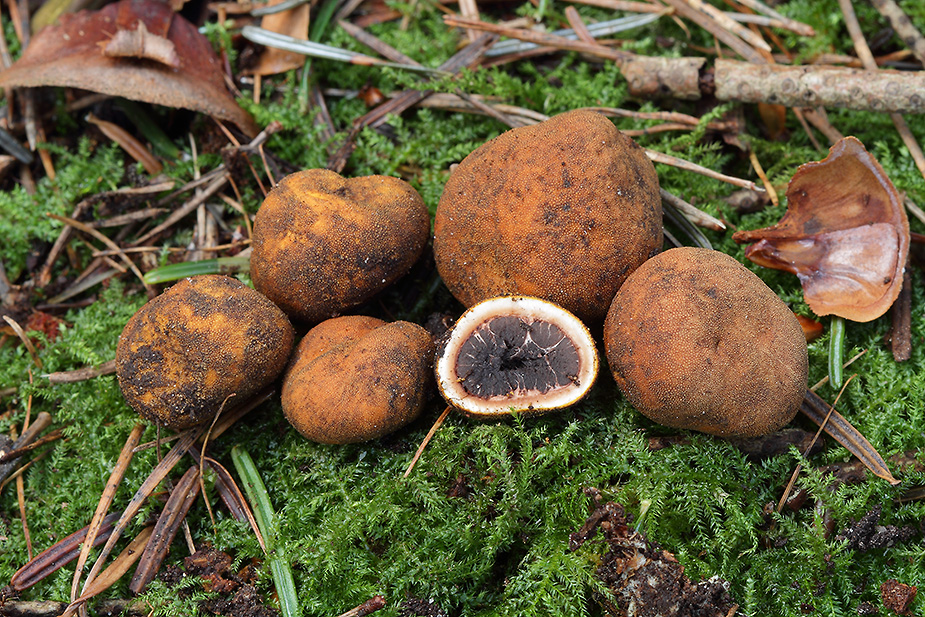
Truffle dishes are very expensive and the mushrooms themselves are considered an exquisite delicacy, since this species is quite rare, grows differently from what we are used to, is harvested with the help of animals and has a very specific taste. Most mushroom pickers believe that these unusual fruits do not grow in Russia, but this is not the case. Knowing what they look like, it is quite possible to find them in our latitudes.
Description of truffles
The name of the mushroom is originally translated as "earth cone", which is quite logical if you look at its external shape.
The structure and features of the species
Usually fruiting bodies are either rounded or tuberous. Some experts note that outwardly they look like potatoes. In addition, depending on the maturity of the tubers, they can be of different consistency (dense or loose).Traditionally, the size is small (slightly larger than a walnut), but sometimes some individual fruiting bodies reach quite impressive sizes and can weigh up to 1 kg.

Edible truffle or not
Experts say it is best to consume it either completely raw or with minimal heat treatment to preserve its taste and aroma. Since if it is stored for a long time, then it can lose all its useful qualities and specific taste.
What is his taste
Experts say that the aroma has a light scent of autumn forest and rotten foliage, as well as ripe fruits, and a little bit of chocolate. It tastes very much like hazelnut, with a light fruity or chocolate aftertaste.
Where and how exactly the fetus grows
A feature of these fruit bodies is that they grow underground next to the roots of not all trees, but only such as oak, beech, hornbeam, linden and poplar at a depth of 5 to 30 cm, but usually somewhere around 20 cm. The most valuable are those that were found just near the oak tree. They grow in small groups, an average of 7 pieces, but you can also find single fruits.
Underground mushroom species
There are over a hundred species of this unusual mushroom. But not all of them are equally valued, because they have different tastes and useful properties. We are only interested in those that are the most famous and most often used in cooking.
White
It is very common on the territory of Russia. The shape is usually an irregular circle, the fruit has a whitish color, which changes over time to yellow-brown. On average, the size is from 5 to 8 cm, but sometimes it can reach 15 cm in diameter. A typical fruit weighs 200-300 grams, and a large one - up to 500 grams.
Practical value [edit | edit code]
Real truffles are edible. They have a mushroom flavor with deep roasted seeds or walnuts and a strong characteristic aroma. If a truffle is immersed in water and held, then it acquires the taste of soy sauce.
The most appreciated by gourmets are Perigord, Piedmont and winter truffles, which grow in oak and beech groves in Southern France, Switzerland and Northern Italy, where they are of great industrial importance. In Russia, one species is found - summer truffle ( Tuber aestivum ) .
In France and Italy, dating back to the 15th century, the practice of searching for truffles growing in the forest with the help of specially trained search dogs and pigs, which have a phenomenally fine scent, is widespread: they are able to smell truffles underground at a distance of up to 20 m. searching for truffles is also the so-called "Hunting for flies"; it is based on the fact that some flies of the thornfly family lay their eggs in the soil in the vicinity of truffles (the larvae of these flies use the fruit bodies of truffles for food), therefore, a truffle can be found under the foliage, having noticed midges swarming above it.
Contrary to popular belief, truffles can still be cultivated. There were already successful attempts in 1808. It was observed that truffles grew between the roots of only a few oak trees. In 1808, Joseph Talon (Joseph talon) planted acorns from those oak trees under which truffles were found. A few years later, when the trees grew, truffles were found under the roots of some of them. In 1847 Auguste Rousseau (Auguste Rousseau) planted 7 hectares with such acorns and subsequently collected a large harvest of truffles, for which he received a prize at the 1855 World Exhibition in Paris.
At the end of the 19th century, 750 square kilometers were planted with truffle groves, from which up to 1000 tons of "black diamonds of culinary" were collected. However, due to the decline of agriculture in France in the 20th century, many of the truffle groves were abandoned. The average fruiting period of truffle oaks is about 30 years, after which the yield drops sharply. As a result, although 80% of all truffles harvested in France come from special oak plantations, the annual harvest has dropped dramatically. Local farmers are opposed to new plantations, fearing a serious drop in prices for this delicious mushroom.The number of harvested truffles is decreasing from year to year. In recent years, the harvest of these mushrooms has not exceeded 50 tons. Currently, truffles are cultivated in the USA, Spain, Sweden, New Zealand, Australia and the UK.
French experts demand to prohibit the mixing of European truffles and Chinese ones, as this ultimately strongly affects the reputation of European products for which such mixtures are issued.
Other truffles
White, or Polish, or Trinity truffle (Choiromyces meandriformis) has a fruiting body with light pulp, similar in appearance and size to a potato. Edible. It grows in the forests of Western Europe, Ukraine, Belarus, as well as in the regions of central Russia (earlier it was mined in large quantities in the vicinity of Aleksandrov and Sergiev Posad).
Among the so-called steppe truffles, "tombolans" (genus Terfezia) are also edible. They grow in Southern Europe, North Africa, South-West Asia - in Azerbaijan on the Absheron Peninsula, in Nagorno-Karabakh, in the valley of the Araks River, in Central Asia and in Turkmenistan (Terfezia transcaucasica). In the same areas, the steppe truffle grows (Terfezia boudieri) .
Sometimes truffles are mistakenly referred to as inedible basidiomycetes from the genus Scleroderma (a group of gasteromycetes), whose fruiting bodies look like round and oblong yellowish tubers 3-10 cm long; found in forests, parks; fruiting bodies are at first dense, blackish inside with light veins, unpleasant smelling; later their contents are sprayed.
Reindeer truffle, inedible for humans, is a species of the Elafomitses genus, which serves as food for rodents and deer.
Truffle (Tuber) is the most expensive mushroom in the world, a rare and tasty delicacy with unique taste and strong specific aroma. The mushroom got its name due to the similarity of its fruiting body with potato tubers or cones (the Latin phrase terrae tuber corresponds to the concept of “earthen cones”). Mushroom truffle belongs to the department of ascomycetes, the subdivision of Pezizomycotina, the class of pec, the order of pec, the family of truffles, the genus of truffles.
Proper storage
In order for the truffle to retain its taste as long as possible, it is necessary to carry out proper storage. If you want to preserve the taste of the mushroom for a long time, it is not recommended to wash it, and in general, to make it in contact with water. That is why truffles collected in the forest just need to be carefully placed in a container and covered with plastic wrap on top. Store the truffles in a cool place in your home or in the refrigerator. Thus, the effect will be created that it is still underground, at a cool temperature, but at the same time, without interacting with oxygen.
However, it is recommended to store mushrooms in this form for no more than one week. Then, it will start to deteriorate and there is a risk of serious poisoning. Treat this information carefully, as it is directly about your health.



